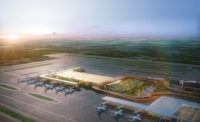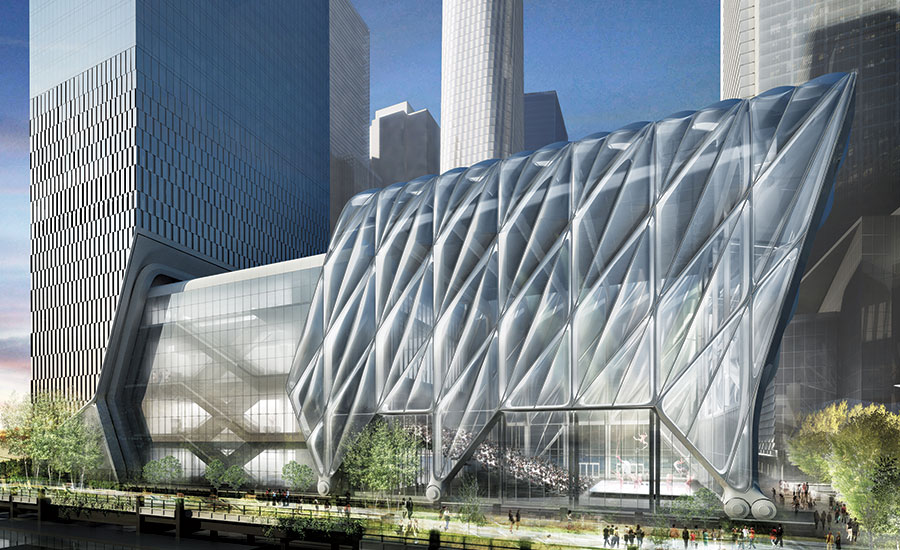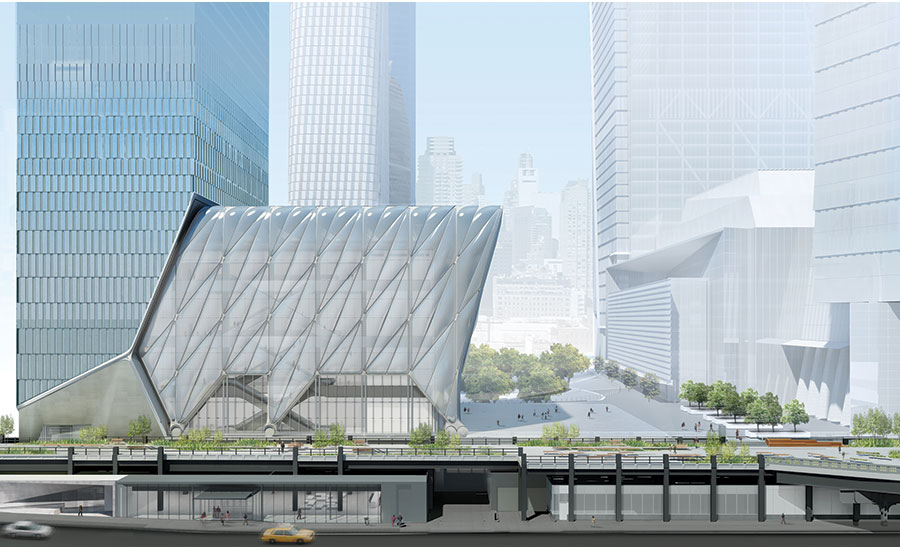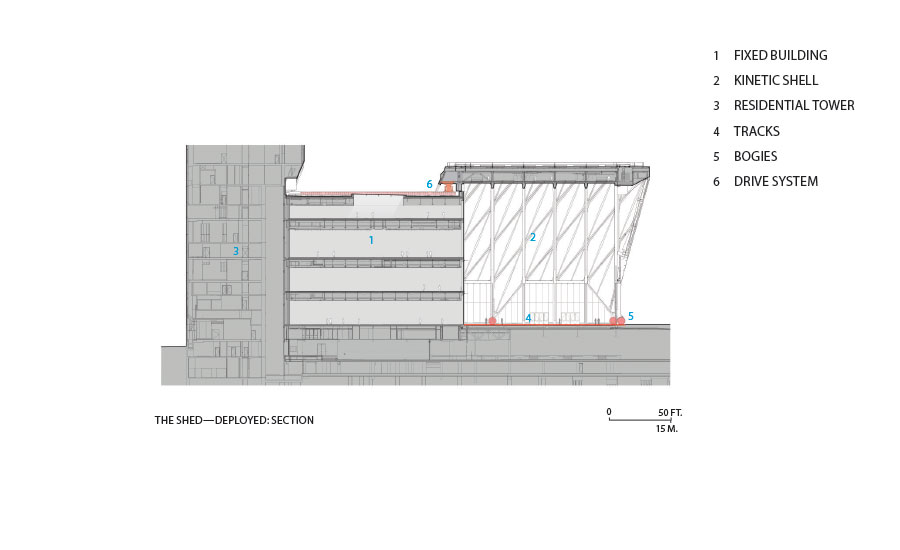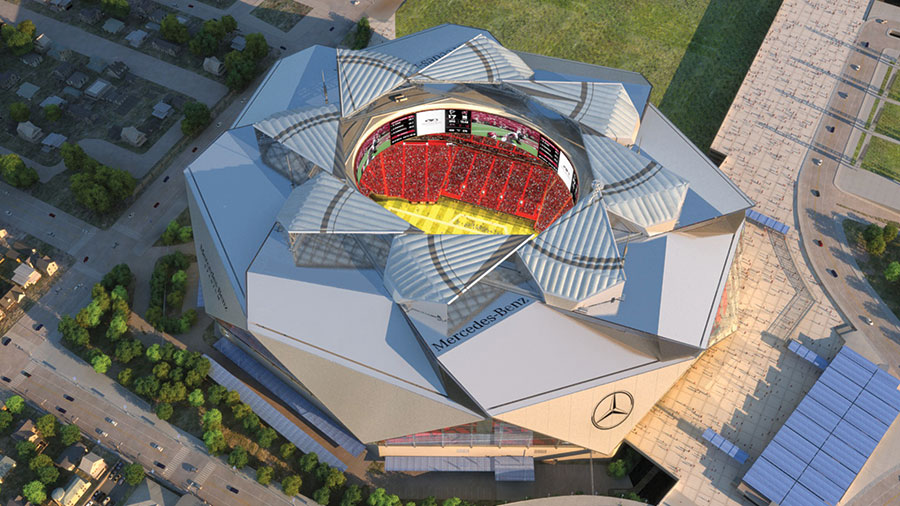Continuing Education: Kinetic Buildings

The Shed, a multidisciplinary arts venue under construction in Manhattan, consists of a fixed building enclosed by a glass cable wall and an ETFE-clad diagrid shell that can be moved to cover a plaza.
Image courtesy Diller Scofidio + Renfro in collaboration with Rockwell Group

The Shed, rising on Manhattan’s far west side—where the High Line meets the development at Hudson Yards—will sit at the base of a new residential tower.
Image courtesy Diller Scofidio + Renfro in collaboration with Rockwell Group

Image courtesy Diller Scofidio + Renfro in collaboration with Rockwell Group

Image courtesy Diller Scofidio + Renfro in collaboration with Rockwell Group

Image courtesy Diller Scofidio + Renfro in collaboration with Rockwell Group

The oval opening over the field at the Mercedes-Benz Stadium in Atlanta will have eight ETFE-clad petals that appear to rotate to open and close the roof. In reality, they each move on a straight line.
Image courtesy Atlanta Falcons

The oval opening over the field at the Mercedes-Benz Stadium in Atlanta will have eight ETFE-clad petals that appear to rotate to open and close the roof. In reality, they each move on a straight line.
Image courtesy Atlanta Falcons

The oval opening over the field at the Mercedes-Benz Stadium in Atlanta will have eight ETFE-clad petals that appear to rotate to open and close the roof. In reality, they each move on a straight line.
Image courtesy Atlanta Falcons

The Mercedes-Benz Stadium’s fixed roof framing consists of a system of trusses that span more than 730 feet between megacolumns and support the retractable petals, which cantilever as much as 200 feet over the oval aperture when closed.
Image courtesy Burohappold

The Mercedes-Benz Stadium’s fixed roof framing consists of a system of trusses that span more than 730 feet between megacolumns and support the retractable petals, which cantilever as much as 200 feet over the oval aperture when closed.
Image courtesy Burohappold

The Mercedes-Benz Stadium’s fixed roof framing consists of a system of trusses that span more than 730 feet between megacolumns and support the retractable petals, which cantilever as much as 200 feet over the oval aperture when closed.
Image courtesy Burohappold

The Mercedes-Benz Stadium’s fixed roof framing consists of a system of trusses that span more than 730 feet between megacolumns and support the retractable petals, which cantilever as much as 200 feet over the oval aperture when closed.
Image courtesy Burohappold

The Mercedes-Benz Stadium’s fixed roof framing consists of a system of trusses that span more than 730 feet between megacolumns and support the retractable petals, which cantilever as much as 200 feet over the oval aperture when closed.
Image courtesy Burohappold

The new operable PTFE roof over the Arthur Ashe Stadium in Queens, New York, is completely independent of the 1997 structure beneath it. The roof can be opened or closed in about six minutes.
Photo © Rafael Gamo

The new operable PTFE roof over the Arthur Ashe Stadium in Queens, New York, is completely independent of the 1997 structure beneath it. The roof can be opened or closed in about six minutes.
Photo © Jennifer Pottheiser

Image courtesy Rossetti

Image courtesy Rossetti

Image courtesy Rossetti


















Buildings are generally designed to be permanent, immutable structures. But this is not always the case. In the early 1960s, the British architect Cedric Price proposed a “Fun Palace” to be built on the banks of the Thames in London. It was to be ever-changing, with moving and reconfigurable walls and floors. Price’s vision was never realized, but a modern-day transformable structure inspired by his ideas and known as the Shed is taking shape in New York, on Manhattan’s far west side, where the High Line meets Hudson Yards. The 200,000-square-foot interdisciplinary arts space, designed by Diller Scofidio + Renfro (DSR) with Rockwell Group, is devised to operate in a variety of modes. Slated to open in spring 2019, the $425 million venue consists of two primary components: a six-level fixed building that houses two galleries, a 500-seat theater, and a rehearsal room, among other elements; and an outer shed or shell that slides to shelter an adjoining 21,000-square-foot plaza and create a multipurpose 120-foot-tall, column-free hall.
The venue’s stationary structure has a conventional steel frame with 100-foot-long clear spans and is enclosed within a glass cable wall. The movable shell, meanwhile, comprises an exposed steel diagrid frame clad in translucent pillows made of the strong but lightweight plastic, Ethylene tetrafluoroethylene (ETFE). Integrated within this cagelike structure are equipment and services, such as power, lighting, theatrical rigging, and ducts, to create what Liz Diller, DSR founding partner, calls an “open infrastructure.”
The shell, whose primary steel weighs 2,400 tons, will travel via a system based on gantry crane technology common in shipping ports. A rack-and-pinion drive moves the shell forward and back on 6-foot-tall bogies, or wheels, that run in tracks at plaza level. It will take about five minutes to completely extend the shell, according to Diller, raising the possibility that its movement could be incorporated into a performance rather than merely in preparation for one. The building is inherently “performative,” says David Rockwell, Rockwell Group founder.
But before deployment, the Shed’s managers must conduct a multistep safety protocol to make sure that the path of travel is clear of obstructions—checking areas that include the plaza, the bogie tracks, and the space directly below the theatrical rigging. The location of the drive system—on the roof of the fixed building—keeps it secure, since the public has no access. The friction and inertia forces from the drive are transmitted through the fixed building’s steel frame, explains Scott Lomax, principal at Thornton Tomasetti, the project’s structural engineer. Its elements have been sized to accommodate these forces, he says.
To deal with the environmental-control issues associated with temporarily enclosing outdoor space, the project team designed the plaza as a radiant floor that can be heated for winter events. In warm weather, the space under the deployed shell will be conditioned with cool air delivered through low-level ducts. Blackout shades can also be extended to make the hall suitable for multiple types of programming. The goal is a responsive, versatile building that can accommodate different media, showcase work at a variety of scales, and adapt to changing technologies. “What art will look like in the future is an open question,” says Diller.
Of course, large-scale kinetic elements in the form of retractable roofs have long been a feature of stadia and ballparks for professional athletic teams. The operable coverings permit play in inclement weather and allow facilities to be used for multiple sports, as well as for other types of events including concerts or trade shows. They can also help facilitate the growth of natural turf.
One venue with a particularly unusual operable roof is the new facility designed by 360 Architecture (now part of HOK) for the National Football League’s Atlanta Falcons. The $1.5 billion Mercedes-Benz Stadium, now under construction and on track for completion next summer, will have an operable roof comprised of eight ETFE-pillow-clad triangular “petals.” These retract, much like the leaves in a camera shutter, to reveal a 380-foot-long and 305-foot-wide oval opening overhead.
The designers and owners envision that the roof will be open most of the time during NFL games, since the Atlanta weather in football season is mild. Bill Johnson, the HOK design principal leading the project, hopes the pool of sunlight that will move around the artificial-turf field during daytime play will bring to mind the Pantheon in Rome. “It was the inspiration,” he says.
It might seem presumptuous to compare a professional-sports venue with one of the most revered works of antiquity, but the stadium is an engineering feat in its own right. The roof includes an outer fixed portion clad in metal and membrane that is folded and faceted to create something that resembles an eight-pointed pinwheel in plan. Its structure is a two-way system of steel trusses that span 730 feet between reinforced-concrete megacolumns positioned just outside the stadium’s seating bowl. This fixed-roof assembly includes backspan members intended to support the upward forces created by the retractable petals, which each weigh as much as 450 tons. They cantilever up to 200 feet—a dimension similar to the length of a city block, notes Erleen Hatfield, a partner at BuroHappold, the project’s structural engineer.
The roof scheme bears the mark of the kinetic design consultant Chuck Hoberman, who was involved in the project’s early phases: although the petals appear to rotate as the roof opens and closes, they move together at a diagonal but straight line. Each travels on a pair of rails set 40 feet apart and supported by the fixed-roof structure. But because of the opening’s oval shape, the petals have different dimensions and weights. This not only made structural analysis more difficult, but it also meant that the petals travel at different speeds, creating an added challenge for synchronization and coordination.
And if the roof system is not complicated enough, it will also support a 58-foot-tall and 1,100-foot-long video scoreboard that wraps the perimeter of the roof opening. This configuration, an alternative to the typical Jumbotron, allows the Falcons’ fans to see the clouds and the sky, but, at 940 tons, it is almost 5 percent of the weight of the entire roof, says Hatfield.
The nodes where steel elements came together are particularly complex. So, to facilitate their coordination, BuroHappold shared its 3-D model with the steel fabricator, ultimately checking the shop drawings in a digital environment. Hatfield says the process was a significant time-saver. She believes that it is the largest project ever to implement 3-D review for its steel package.
The roof isn’t the only moving or adaptable element at the Mercedes-Benz Stadium. To reduce seating capacity for events such as soccer matches, corner sections of the stadium bowl retract, while upper portions can be closed off with a motorized curtain. The aim is to minimize conversion time, says Scott Jenkins, the facility’s general manager.
Compared with the Atlanta facility, the new roof over the Arthur Ashe Stadium at the Billie Jean King National Tennis Center in Queens, New York, appears almost straightforward: the slightly domed 236,600-square-foot canopy contains two 500-ton rectangular panels that separate to frame a 250-foot-square slice of the sky. Designed by the Detroit-based architecture firm Rossetti, the new roof is the United States Tennis Association’s response to rain delays that in recent years had regularly plagued the U.S. Open Tennis Championships held in the late summer at the Flushing Meadows complex.
But devising and constructing the $150 million shelter for the almost 24,000-seat venue was not so simple. The primary complicating factor: the original 1997 stadium, which was also designed by Rossetti, had not been conceived to support a roof. So the new element would need to be wholly independent of the original’s precast-concrete seating bowl and steel structure. What’s more, the team was hampered by the marshy site, which had been used as an ash dump. Ahmad Rahimian, the U.S. director of building structures for WSP, the project’s structural engineer, sums up the challenges as “poor soil, long spans, and a tight budget.”
Rossetti principal Jon Disbrow refers to the solution as “an umbrella,” but one that straddles the existing stadium. It is supported on eight steel columns—each with two branchlike braces—placed just outside the corners of the existing building’s octagonal footprint. The columns, which sit on top of piles as deep as 200 feet, hold up four nearly 500-foot-long trusses, two spanning in each direction. These in turn support a network of steel joists and bracing, over which a membrane of Polytetrafluoroethylene (PTFE)—a lightweight material resistant to heat and UV degradation—is stretched.
The new roof was built without disrupting the U.S. Open schedule. It was constructed, starting in late 2013, in three discrete phases, each conducted in the 11½-month period between tournaments: first the foundation work, then the primary steel structure, and finally, this summer, the retractable-roof components and PTFE skin.
Now that the new roof is in place, it looks as though it was always intended to be there, adding a bit of interest to the stadium’s slightly stubby profile. But one aspect of the newly covered stadium that not everyone is pleased with is its acoustics. Some players at this summer’s Open reportedly complained that the roof amplifies the noise made by the spectators, making it hard to concentrate. As part of Rossetti’s design, perforated metal panels backed with mineral wool were installed at the roof’s perimeter to dampen reverberation, according to Disbrow. He says that additional measures could be implemented, but so far the USTA hasn’t asked the firm to do so.
Although acoustics may still need to be addressed, the new canopy does work admirably in a variety of modes and conditions, as any adaptable building should. Even in the open position, the majority of the venue’s seats are in shade, shielded by the fixed roof’s PTFE skin, which blocks 90 percent of visible light. So even though the new lid was conceived primarily as an umbrella, it also serves as a parasol, allowing fans to enjoy tennis at Arthur Ashe, rain or shine.
The completions of Mercedes-Benz Stadium and the Shed are still in the future. It is not yet clear if the highly mechanized buildings will function as flawlessly as their designers predict. Or, more to the point, if they will readily adapt to needs that have yet to be identified. But Jenkins in Atlanta is confident. He says the roof has been mocked up and thoroughly tested and that its controls are straightforward. But he does concede that “until we actually operate it, we won’t know what we don’t know.” His project and others could be just the beginning of a future for flexible architecture that may be even more fun than Cedric Price dreamed long ago.
Shed Fly Through Animation
Courtesy the Shed
|
Continuing Education

To earn one AIA learning unit (LU), including one hour of health, safety, and welfare (HSW) credit, read “Movable Feasts,” review the supplemental material listed below, and complete the online test. Upon passing the test, you will receive a certificate of completion, and your credit will be automatically reported to the AIA. Additional information regarding credit-reporting and continuing-education requirements can be found online at continuingeducation.bnpmedia.com.
Supplemental Material Mercedes-Benz Stadium Animation Courtesy the Atlanta Falcons
Raising the Roof on the Mercedes-Benz Stadium Courtesy the Atlanta Falcons
Stadium Roofs Offer much More than Shelter Joann, Gonchar, AIA, and Peter Reina
Learning Objectives 1 Discuss the design, construction, and operational challenges presented by buildings with large-scale kinetic elements. 2 Describe three such current projects and explain the mechanisms that allow their kinetic elements to move. 3 Explain the structural solutions presented by these projects. 4 Explain the indoor environmental-control solutions presented by these projects.
AIA/CES Course #K1610A
For CEU credit, read "Movable Feasts" and take the quiz at continuingeducation.bnpmedia.com, or use our architectural record continuing-education app, available in the itunes store. structure, finishes, and other original fabric when
a building is moved.
significant buildings.
|



